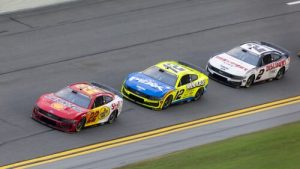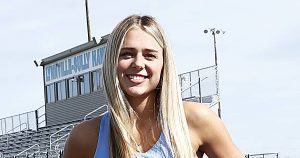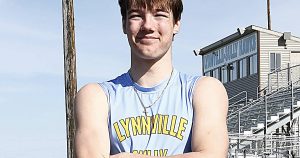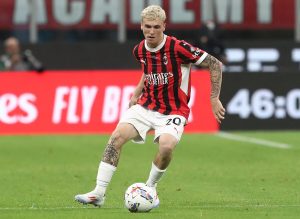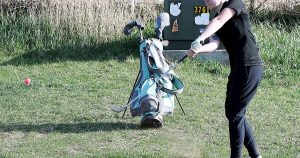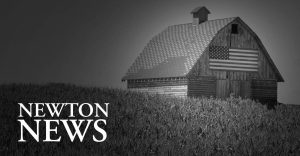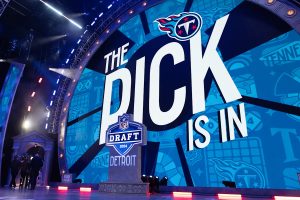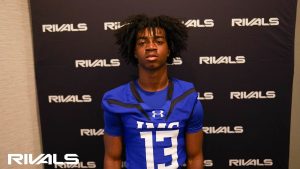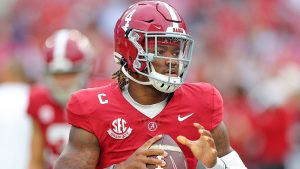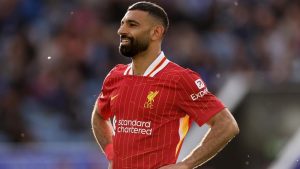Is the NL West the best division ever? Are the Braves cooked? Is Jung Hoo Lee a superstar?

April is both the best and worst month of the baseball season. It’s the best month because baseball’s back! Spring training games are fun in their own way, but April brings the return of meaningful baseball, and that’s what we all love. Games with stakes and performances that matter. The story of the season begins in April. It’s the best time of the year.
At the same time, April is the worst month because it is full of lies, man. The Mariners had the best record in the AL West last April. Alec Bohm led the league in batting average. Kutter Crawford led all pitchers in WAR. We all want to believe in the good stuff while dismissing the bad stuff as “it’s still early.” It’s difficult, I know, but you have to give the season a chance to breathe.
With that in mind, let’s play a game of MLB Fact or Fiction. Here are 10 prominent storylines as we enter the season’s fourth week, then we’ll suss out what’s real and what’s fake. Come with me, won’t you?
1. The NL West is the best division ever
The case for: All you need to do is look at the standings. Here are the best records in baseball:
- Padres: 16-6
- Dodgers: 16-7 (0.5 GB)
- Mets: 15-7 (1 GB)
- Yankees: 14-8 (2 GB)
- Giants: 14-8 (2 GB)
- Diamondbacks: 13-9 (3 GB)
Four of the six best teams in baseball are in the NL West. By run differential, the NL West houses four of the top 10 teams in baseball, including No. 2 (Padres at plus-35) and No. 6 (Giants at plus-30). The D-backs, Dodgers, Giants, and Padres are a combined 53-30 against the other five divisions. That’s a 103-win pace in a 162-game season.
The projection systems agree as well. FanGraphs says four of baseball’s top eight teams play in the NL West. SportsLine says the NL West has four of the top nine teams. Baseball Prospectus is the low man. They say only four of baseball’s top 12 teams are in the NL West. The play on the field to date supports the “best division ever” argument, and the projection systems like it too.
The case against: It’s a five-team division, right? The Rockies do exist; we can’t just conveniently ignore them. They have the worst record in baseball (4-17) and can you really be the best division ever if one of the five teams has the league’s worst record? Four wins through 21 games is only one win better than last year’s 121-loss White Sox in the same time period. The Rockies have been that bad so far.
The best divisional record ever belongs to the 2002 AL West, in which four teams went a combined 367-281 (.566). For five teams, a .566 winning percentage equals 459 wins. If the Rockies lose “only” 110 games, the other four teams NL West teams must average 102 wins to beat that .566 winning percentage. Can four teams in one division really combine for 408 wins? Yeah, maybe they can, but that is a tall order.
Verdict: Fiction. The Rockies ruin it. If the Rockies could be a more normal 90-loss team rather than a potential 110-loss disaster, I might put this one down as a fact, but I’m comfortable assuming they lose that many games. I don’t think it’s too much to ask that the “best division ever” doesn’t also include the team with the worst record in baseball.
The case for: Soto’s first season with the Mets is off to a sluggish start. He’s hitting .256/.385/.436 after Sunday’s two-hit game, numbers that are great for most players but decidedly un-Soto-like. This is a player who came into 2025 as a career .285/.421/.532 hitter and received the richest contract in North American pro sports history. By his standards, Soto’s off to a slow start.
Last week, Soto admitted that teams are pitching him differently this year than they did last year, when he slugged a career-high 41 home runs and finished third in the AL MVP voting. Why are they pitching him differently? Because he no longer has Judge hitting behind him, and Judge is the game’s most fearsome hitter. There is no better lineup protection in the game.
“It’s definitely different. I had the best hitter in baseball hitting behind me,” Soto said last week. “I was getting more attacked and more pitches in the strike zone, less intentional walks and things like that. I was pitched differently last year.”
The numbers don’t really back this up: 45.8% of the pitches Soto has seen this season have been in the zone. It was 47.3% last year, so only a small difference, and still well south of the 51.5% league average. It’s not like pitchers pounded the zone against Soto when he had Judge behind him. He’s seeing roughly the same number of pitches in the zone this year as last year.
The case against: This is the eighth season in what is shaping up to be a Hall of Fame career and in only one of those eight seasons did Soto have Judge hitting behind him. He was a terrific hitter before teaming up with Judge — Soto entered 2024 with a career .284/.421/.524 slash line — and he’s only 26. It’s not like this is an aging hitter who needs all the help he can get.
Also, Pete Alonso has hit behind Soto every game this season and he’s having a fantastic year: .346/.453/.718 with six home runs. Alonso is not Judge, but he is a thunderous hitter in his own right, and not someone opposing teams want to pitch to with men on base. It’s not like Soto has gone from being protected by the best hitter in baseball to a slap hitter, you know?
Verdict: Fiction. Soto will be just fine. He was a great hitter before he became Judge’s teammate and he will be a great hitter after being Judge’s teammate. More than anything, Soto’s slow start can be attributed to a 3 mph (!) decline in bat speed, and thus less hard contact. What’s up with that? That’s not something we can attribute to not having Judge behind him. Hmmm.
3. The Cubs have baseball’s best offense
The case for: Let’s start with the stats, which are the record of what happened on the field. The Cubs lead baseball in runs scored per game (6.04) and not by a little either. The Yankees are second at 5.73. Six times the Cubs have scored double-digit runs, twice as many as any other team, and 10 times they’ve scored at least seven runs. No other team has done it more than seven times.
Here are Chicago’s slash line ranks this season:
- Batting average: .258 (5th in MLB)
- On-base percentage: .338 (5th in MLB)
- Slugging percentage: .447 (2nd in MLB)
Other than backup catcher Carson Kelly and maybe first baseman Michael Busch, no one in the lineup is performing far out of line with expectations. Kyle Tucker and Seiya Suzuki are, once again, two of the best hitters in baseball. They’re the sport’s best 1-2 lineup punch right now.
If anything, there is some underperformance on offense. Dansby Swanson (.567 OPS) is off to a terrible start, Ian Happ (.676 OPS) has been so-so, and third base (.502 OPS) has been a black hole no matter who the Cubs have put there. With any luck, Happ and Swanson will get back to their career norms as Busch and Pete Crow-Armstrong level off.
Not only are the Cubs hitting, they’re also stealing. They’ve stolen 31 bases, third most in baseball, and they’ve been caught only four times. That’s an 89% success rate. Combine a good, deep lineup with elite speed and you have a recipe for the game’s highest scoring offense. The Cubbies have looked dynamic.
The case against: The biggest red flag with Chicago’s offense is that some of their situation stats are unsustainably good. Will they continue to be 40% better than the average team with runners in scoring position? Walk nearly as much as they’ve struck out with two outs and runners on base? Be the game’s best hitting team in high-leverage situations? Stuff like that.
Two things can be true. The Cubs have a really good offense and their sequencing (clustering hits together in an inning, walks before homers rather than the other way around, etc.) has been about the best in baseball. That last part is difficult to sustain over the course of the long season. Some of these situational hitting outliers figure to return to Earth as the season progresses.
Verdict: Fact. Even with some regression to be expected, I do think the Cubs have the pieces to be the game’s top offense. Tucker and Suzuki are star hitters and the Cubs have good to great hitters everywhere except third base. The speed matters too. It’s extra bases and it’s disruptive. The Cubs drive pitchers mad when they have ducks on the pond. It’s a legitimately great offense.
4. The Braves are cooked
The case for: Well, they’re in last place in a division that includes a tanking Marlins team and a Nationals club with an ownership group that seems disinterested in surrounding their young core with free agents, so that’s pretty bad. The Braves started the season 0-7 and have rebounded to go 8-6 in the 14 games since. They’re playing better, but they’re not exactly dominating.
Matt Olson had a down year last season and is slugging only .411 this year even after Sunday’s homer. Michael Harris II has been among the game’s worst hitters so far this year (.203/.266/.354). In any given game, Atlanta’s lineup includes some combination of Nick Allen, Orlando Arcia, Jarred Kelenic, Alex Verdugo, and Eli White. That is too much fringe MLB talent.
Max Fried and Charlie Morton left as free agents and were replaced by no one in particular. Chris Sale’s NL Cy Young follow-up is off to a rocky start. Reynaldo López is out long-term following shoulder surgery. There are red flags up and down the pitching staff and the offense hasn’t been nearly good enough to compensate. In a deep NL, the Braves are already in a tough spot.
The case against: Spencer Strider returned last week and looked very good. It won’t be too much longer before Ronald Acuña Jr. rejoins the team. The Braves have reinforcements on the way. Impactful ones too. Even if Acuña and Strider are 75% of their usual selves this year, they’re still great players. The Braves have several internal rotation options to cycle through this summer too.
Also, GM Alex Anthopoulos has earned the benefit of the doubt when it comes to beefing up the roster in-season, be it at the trade deadline or with smaller moves along the way (waiver claims, etc.). You can be sure he’ll attack the team’s weaknesses. There is a lot — A LOT — of season still to be played. Give the Braves a chance to be whole with Acuña and Strider before burying them.
Verdict: Fiction. That isn’t to say Braves fans can’t be annoyed (I would be) or that the Braves haven’t hurt their postseason odds (they have), but it is a long season folks. Starting poorly and finishing strong is an NL East specialty. The Mets did it last year, the Phillies in 2022, the Braves in 2021, the Nationals in 2019, etc. Sorry, but I refuse to count out this team in April.
5. Hunter Greene is the best pitcher in baseball
The case for: Five starts into 2025, Greene has a 2.35 ERA with 35 strikeouts and only six walks in 30 ⅔ innings. Opponents are hitting .164/.220/.336 against him. This is not a five-start sample either. Since last July 1, 110 pitchers have made at least 14 starts. Here’s where Greene ranks among those 110 pitchers:
- ERA: 1.51 (2nd to Blake Snell’s 1.31 ERA)
- WHIP: 0.75 (1st in MLB)
- Opponent’s average: .142 (2nd to Snell’s .140)
- Strikeout rate: 29.9% (9th in MLB)
- WAR: 4.5 (1st in MLB)
To put it another way: Greene has a 1.51 ERA and has allowed three baserunners every four innings in his last 14 starts and 83 ⅔ innings. Those are elite closer numbers as a starting pitcher. The Reds‘ ace was a high draft pick (No. 2 overall in 2017) who, at age 25, appears to have taken The Big Leap. Greene is a budding star, if he’s not one already.
The case against: Greene might not even be the best pitcher in the NL Central. Paul Skenes exists, right? Yoshinobu Yamamoto has been out-of-this-world good this season. Hunter Brown, Garrett Crochet, Max Fried, and Logan Webb are all right there with Greene in terms of per-inning dominance this month. The sport is not lacking top flight starters these days.
Also, shouldn’t there be a track record component to the “best pitcher in baseball” conversation? Or are 14 starts enough to decide it? Tarik Skubal, the reigning AL Cy Young winner, has been outstanding to start the season. Zack Wheeler has been the sport’s best combination of volume (lots of innings) and dominance in recent years. He has to be included in any “best pitcher in baseball” talk.
Verdict: Fiction. This is not intended to be a knock Greene. He’s excellent. I think he’s at least a top-10 pitcher in the game, maybe top five. I’m just not ready to move him to the top of the list just yet. His career highs are the 26 starts and 150 ⅓ innings he threw last year. I think we need a larger body of work before declaring Greene the game’s top starter. He is so, so good though.
The case for: Development is not linear. Young players, even former No. 1 overall picks like Torkelson, can experience ups and downs before settling in at the highest level. Torkelson was drafted in 2020, debuted in 2022, slugged 31 home runs in 2023, got demoted to Triple-A in 2024, and now he’s hitting .288/.392/.628 with seven home runs in the early days of 2025.
Torkelson’s hot start has been fueled by approach and mechanical tweaks. He’s pulling the ball much more than in the past and that has led to more power, both in terms of home runs hit and exit velocity generated, and he’s also adopted a more narrow and open stance. To put it another way, Torkelson is putting himself in better position just to see the ball, and thus react.
There are very few true talent 1.000 OPS hitters in the game and we don’t have nearly enough evidence to say Torkelson is one of them, but you don’t have to be a 1.000 OPS guy to be a really good hitter. Torkelson’s underlying numbers are strong — his .601 expected slugging percentage is a top-16 mark in baseball — and the adjustments are a tangible reasons to buy his hot start.
The case against: This is not Torkelson’s first great 20-something-game stretch. He had several 20-game stretches with a 1.000 OPS in 2023 and even last year he had a few two-week spans where he slugged close to .600. When a guy does this in the middle of the season, it’s a hot streak. When he does it to start the season, we’re asking if it’s a breakout. So it goes.
We can’t completely ignore the track record either. A great start to the season does not wipe away the last three years. That’s still relevant information. The fact of the matter is the Tigers pushed Torkelson out of the picture over the winter. They signed Gleyber Torres, moved Colt Keith to first, and made Torkelson earn a roster spot. Not even the Tigers expected this.
Verdict: Fact. This is legit. He’s not going to slug .628 all year — very few players do that — but I think Torkelson has arrived as a legit middle-of-the-order masher. He’s the kind of hitter who can anchor a contender’s lineup. Even the most talented players can need a few years to find their way in the show. Torkelson took his lumps from 2022-24, made the necessary adjustments over the winter, and is reaping the rewards now. I’m in.
The case for: There is still a week to be played in April and Clase has already allowed nearly twice as many earned runs this year (nine) as he did all of last year (five). Loop in last postseason, and Clase has surrendered 17 runs (all earned) and four home runs in his last 17 ⅓ innings. That’s after allowing 10 runs (five earned) and two homers in 74 ⅓ innings last regular season.
Furthermore, Clase has lost about 1 mph off his slider and a tick under that off his cutter. After running a stellar 57.8% ground ball rate last year (career 60.0%), it’s down to 47.5% this year. His average exit velocity allowed is up roughly 3 mph. His hard-hit rate (i.e. percent of batted balls with 95 mph exit velocity) has jumped from 29.7% last year (elite) to 40.0% this year (league average).
Simply put, hitters are squaring Clase up more often this year than they did last year, and not by a little either. He’s allowed a run in five of his 11 appearances and has not had a single 1-2-3 inning this season. (To be fair, he did have a 1-2-3-4 inning with an error by the shortstop mixed in.) The game’s best closer in 2024 has not been nearly as automatic to start 2025.
The case against: Clase has run into rotten luck this season. His .487 batting average on balls in play is astronomical and close to double his career .256 rate. That’s not the kind of thing that lasts all year. Also, the gap between Clase’s expected stats based on exit velocity, launch angle, et al, and his actual stats are among the largest in baseball. The numbers:
| Actual | Expected | |
|---|---|---|
|
Batting average |
.426 |
.268 |
|
Slugging percentage |
.617 |
.406 |
Those expected numbers are good more than elite and much higher than last year’s (.214 xBA and .303 xSLG), but it wasn’t reasonable to expect Clase to repeat his 2024 season in 2025 anyway. His 2024 was one of the seasons that doesn’t happen again, like Zack Britton’s 2016 or Edwin Díaz’s 2022. You can be great without having a 0.61 ERA and 0.68 WHIP, you know?
Verdict: Fiction. Guardians fans are free to be annoyed that Clase is making the ninth inning more interesting than they’re used to, but I wouldn’t worry yet. He’s only thrown 10 ⅓ innings. Give the season a chance to breathe. Clase’s 18.6% swinging strike rate is great and far above last year’s 15.3%. That he’s missing so many bats is a good sign. Eventually the batted ball luck will go his way.
8. The Orioles don’t have enough starting pitching
The case for: Even before Sunday’s disaster, the Orioles ranked 28th in rotation ERA (5.62) and were dead last in WAR (minus-0.2) and FIP (5.34). They also had the lowest strikeout rate in baseball (15.6%) and the highest home run rate (1.81 HR/9). Then Charlie Morton got blasted for seven runs in 2 ⅓ innings. Now the O’s are dead last in rotation ERA as well (6.11).
The surface stats are bad and so are the underlying numbers (FIP, etc.). Look at Baltimore’s rotation depth chart:
RHP Zach Eflin(out with lat strain)RHP Grayson Rodriguez(out with elbow inflammation/shoulder discomfort)RHP Kyle Bradish(rehabbing from Tommy John surgery)- RHP Charlie Morton (10.89 ERA)
- RHP Tomoyuki Sugano (8 K in 21 IP)
- RHP Dean Kremer (6.41 ERA)
- RHP Kyle Gibson (likely to join the rotation around May 1)
RHP Tyler Wells(rehabbing from elbow surgery)- LHP Cade Povich (6.38 ERA)
RHP Albert Suárez(out with shoulder inflammation)LHP Trevor Rogers(out with knee injury)- RHP Brandon Young (one career MLB start)
Eflin could return fairly soon, though Rodriguez’s timetable is uncertain, and Bradish and Wells won’t be options until the second half, if at all. The current rotation is a little long in the tooth (Gibson, Morton, and Sugano are all 35 or older) and neither Kremer nor Povich have especially high ceilings. They’re innings dudes more than difference-makers, which is fine. Teams need innings dudes.
On paper, Baltimore’s rotation was lacking coming into the season, and things have only gotten worse with the Eflin, Rodriguez, and Suárez injuries. Expecting pitchers to return from arm injuries to make an impact is tricky, especially when they have so much rehab work ahead of them like Bradish, Rodriguez, and Wells. The cavalry is 37-year-old Gibson. That’s it right now.
The case against: Does any team have enough starting pitching? Other than the Dodgers and Phillies, I don’t think so. It is true that Baltimore’s rotation has performed worse than any other rotation to date, though I’m not convinced Kremer, Morton, and Povich are true talent 6+ ERA guys. It’s reasonable to think there is some positive regression on the way. The question is do they regress to league average? Better than that? Slightly worse? That will depend on health as much as anything.
Verdict: Fact. I mean, easily a fact. The surest fact among our 10 Fact or Fiction scenarios. Here is all you need to know about Baltimore’s rotation:
Baltimore’s current rotation predicament is the perfect storm of injuries, things going wrong every which way on the field and front office/ownership complacency. The Rogers trade has been a complete dud and a lack of financial investment limited GM Mike Elias to low-cost short-term commitments this past offseason, which leads to low-upside signings. The good news is there is plenty of time for Elias to get help, but sheesh, the rotation is so far below what a contender’s should be right now.
The case for: We did not get much of a look at Lee last season, his first MLB season with the Giants, because he crashed into the center field wall on May 12 and needed season-ending shoulder surgery. He didn’t wow before the injury (.262/.310/.331) and we didn’t get a chance to see how he’d adjust later in the season. Lee entered 2025 as a bit of an unknown still.
The first few weeks could not be going much better for Lee or the Giants. The 26-year-old is hitting .333/.389/.593 even after Sunday’s 0 for 5, and he leads baseball with 10 doubles. His contact and exit velocity numbers are good. Shockingly good, really. Lee puts the bat on the ball frequently and he really drives it. The numbers:
| Lee | MLB average | |
|---|---|---|
|
Strikeout rate |
14.4% |
22.5% |
|
Swinging strike rate |
6.9% |
12.1% |
|
Average exit velocity |
90.2 mph |
89.4 mph |
Statcast’s expected stats tell us about the contact quality a player is making more than they provide a hard and fast “he should be hitting this and slugging this” guide. Lee’s expected batting average (.337) and expected slugging percentage (.521) are very strong and support his slash line. This isn’t a guy dinking and dunking his way to success.
Add in aggressive baserunning and some highlight reel plays on defense, and you have a very fun player performing at a high level. Lee is an entertainer as much as he is a baseball player. There’s a “you can’t take your eyes off him” element to his game. Performance is part of it, for sure, but fans also should want to watch you if you’re a star. Lee qualifies.
The case against: Lee is essentially a rookie. Last year’s injury limited him to only 37 games, so we’re talking about a player who’s yet to play 60 games or take 250 plate appearances in the majors. The league hasn’t really had a chance to dive into his weaknesses, make adjustments, and force him to adjust back. We’re still learning about the guy.
To put it another way, you can’t be a star after only 58 games, can you? Players, even mediocre ones, have great 21-game stretches all the time! Players should perform like stars for more than a month before we declare them stars. Lee has pedigree as one of the best players in Korean baseball history, but the body of work in MLB remains very small.
Verdict: Fact. Lee rules. What a fun player. He won’t hit .333 all season because no one does that, but all the ingredients are there to be an above-average hitter (plate discipline, contact rates, exit velocity, etc.), plus he’s a good defender and baserunner, and flashy. Flashy is good. Lee performs and entertains. If only there were more players like him in the league.
10. The Rockies, not the White Sox, are MLB’s worst team
The case for: We started our Fact or Fiction exercise with the top of baseball’s standings. Now here is the bottom:
30. Rockies: 4-17
29. White Sox: 5-16 (1 GB)
28: Twins: 7-15 (1.5 GB)
27. Pirates: 8-15 (2 GB)
26. Braves: 8-13 (3 GB)
The Rockies also have baseball’s worst run differential at minus-51, so they’ve been outscored by 2.4 runs per game, on average. The White Sox are next worst with a minus-26 run differential. Despite playing home games in Coors Field, the Rockies have scored the fewest runs in baseball (65). They’ve also allowed the most runs in baseball (119). Yeesh. That’s a bad, bad combination.
Also, look at the division the Rockies play in. We started by asking if the NL West is the best division ever, which is a valid question even if I don’t think it is true. Colorado has to play just about one-third of their games against the D-backs, Dodgers, Giants, and Padres. As a result, they have baseball’s toughest remaining strength of schedule, per FanGraphs. That is rough.
The case against: The White Sox are really bad too. That 5-16 record through 21 games isn’t much better than last year’s record through 21 games (3-19), a season in which they went on to lose a modern record 121 games. The Rockies are at least trying to be better. They’ve already fired their hitting coach and have called up top prospects Chase Dollander and Zac Veen. The Rockies are bad but are at least making an attempt to improve. Who knows? It might actually work.
Verdict: Fact. The White Sox are really bad too, don’t get me wrong, but the Rockies are bad and rudderless. The hitting coach wasn’t holding them back. In a way, the Rockies are refreshing. A throwback to the days when teams were bad and didn’t know why instead of bad on purpose. The White Sox not getting beat up as much in the sad sack AL Central is enough of a separator for me to say the Rockies are now baseball’s worst team.

